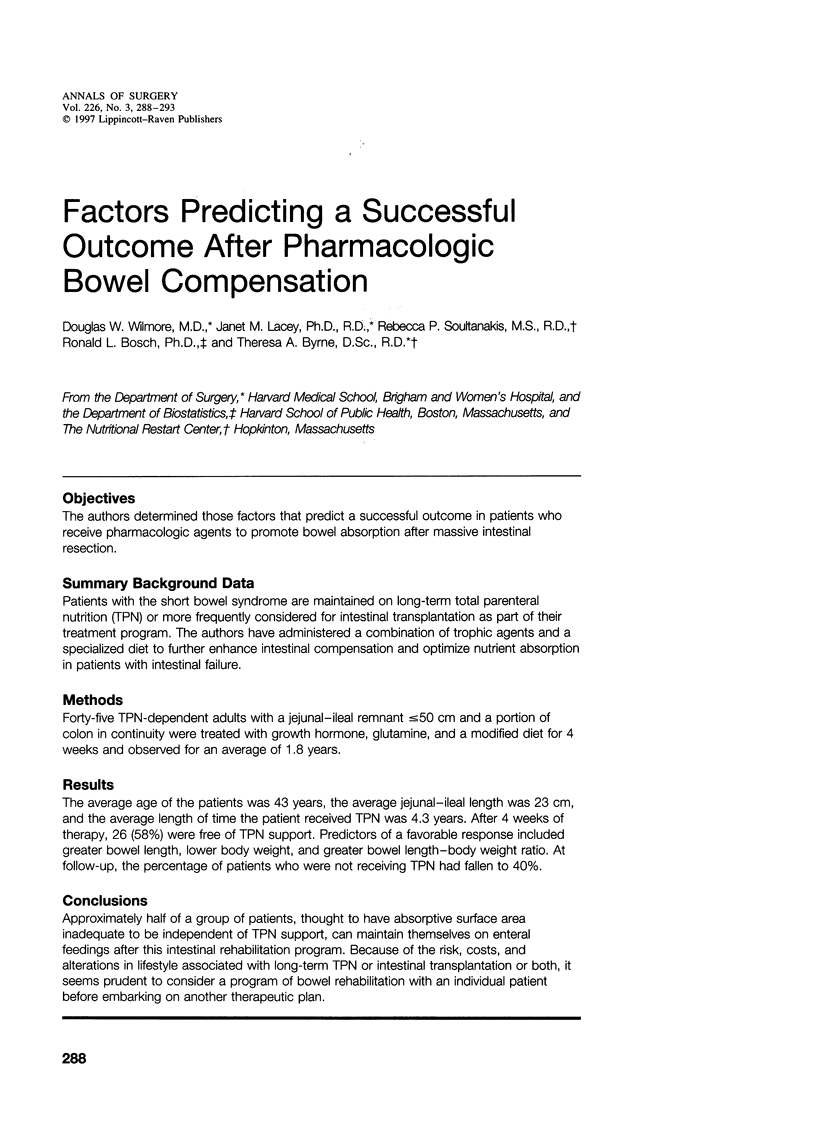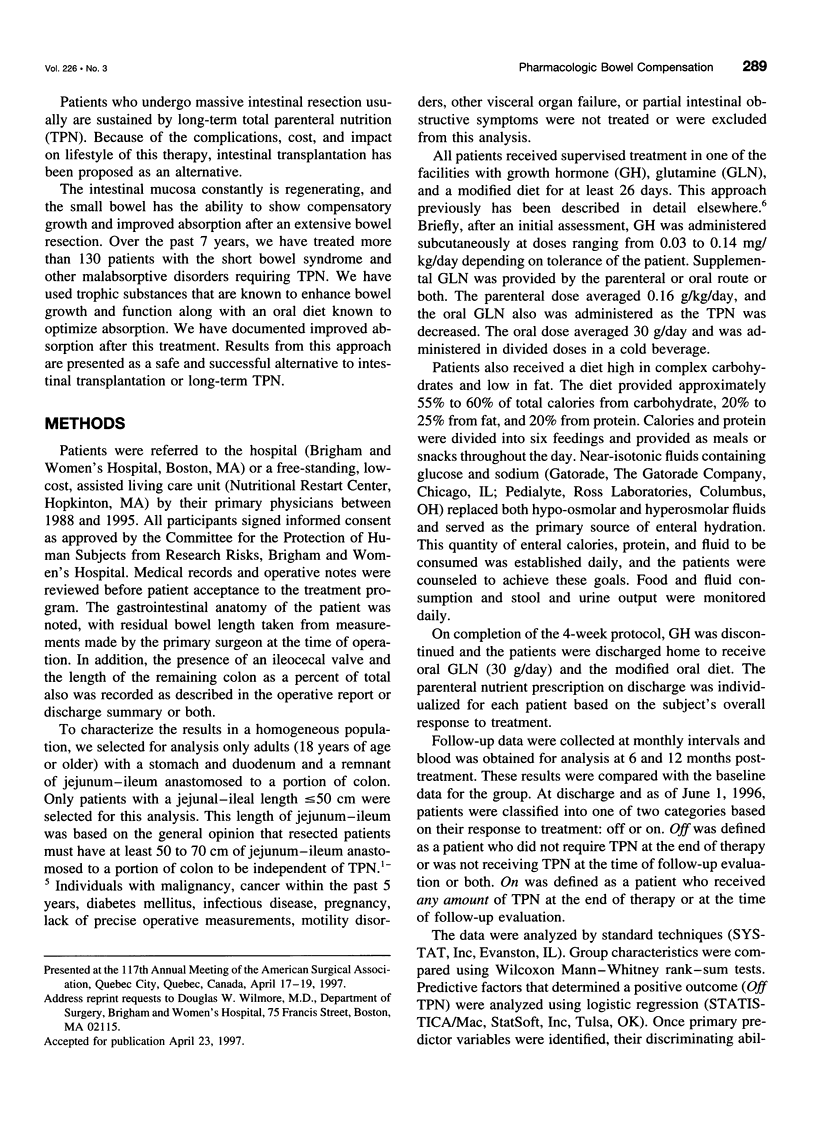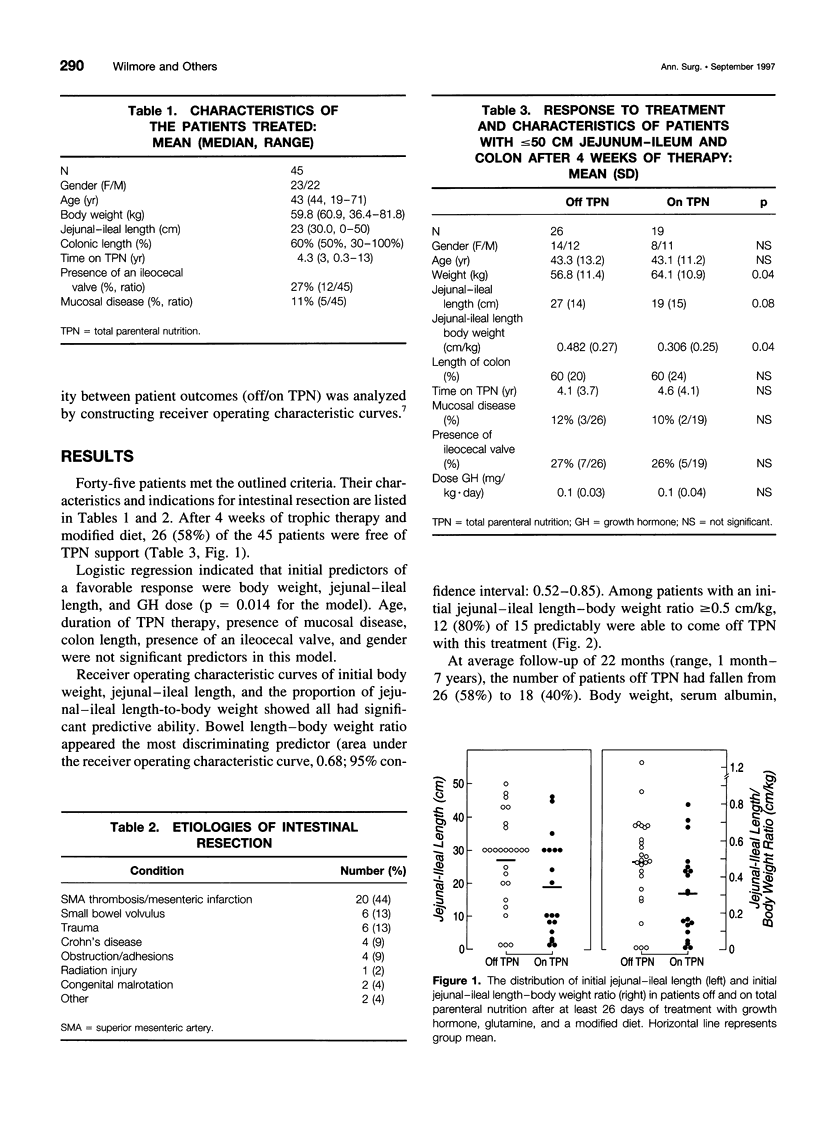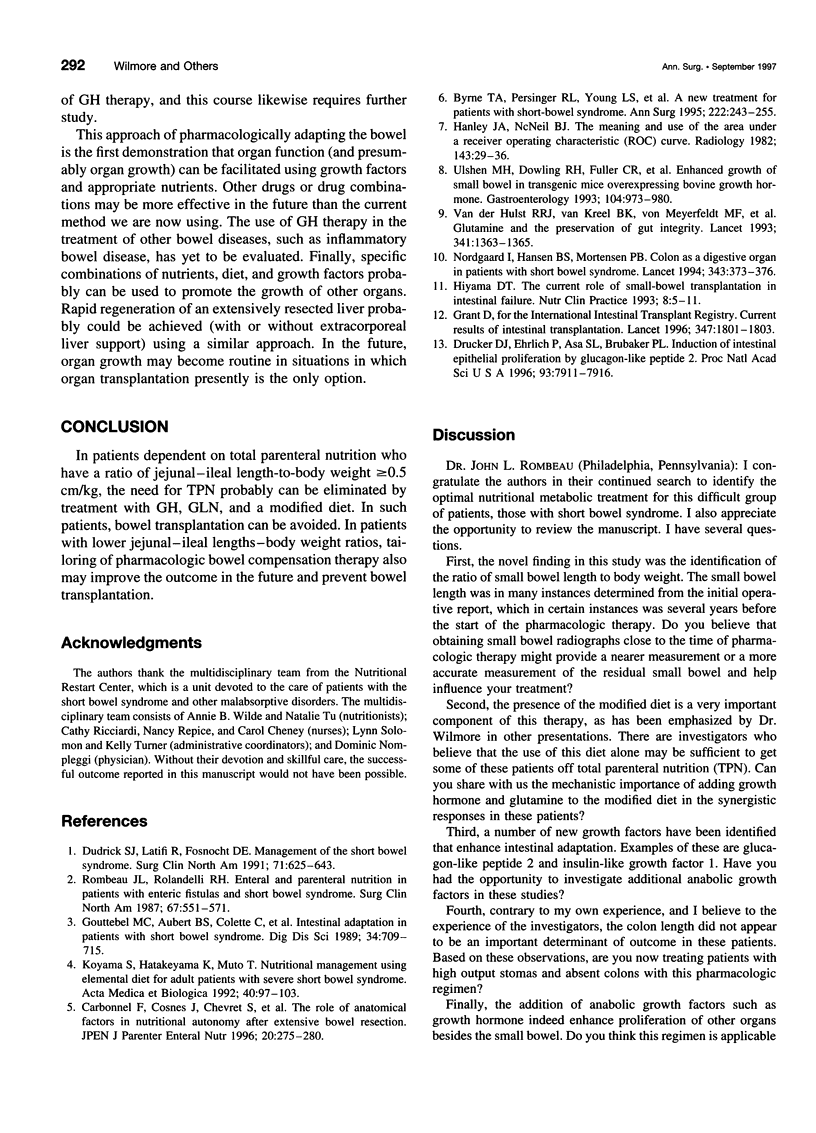Abstract
OBJECTIVES: The authors determined those factors that predict a successful outcome in patients who receive pharmacologic agents to promote bowel absorption after massive intestinal resection. SUMMARY BACKGROUND DATA: Patients with the short bowel syndrome are maintained on long-term total parenteral nutrition (TPN) or more frequently considered for intestinal transplantation as part of their treatment program. The authors have administered a combination of trophic agents and a specialized diet to further enhance intestinal compensation and optimize nutrient absorption in patients with intestinal failure. METHODS: Forty-five TPN-dependent adults with a jejunal-ileal remnant < or = 50 cm and a portion of colon in continuity were treated with growth hormone, glutamine, and a modified diet for 4 weeks and observed for an average of 1.8 years. RESULTS: The average age of the patients was 43 years, the average jejunal-ileal length was 23 cm, and the average length of time the patient received TPN was 4.3 years. After 4 weeks of therapy, 26 (58%) were free of TPN support. Predictors of a favorable response included greater bowel length, lower body weight, and greater bowel length-body weight ratio. At follow-up, the percentage of patients who were not receiving TPN had fallen to 40%. CONCLUSIONS: Approximately half of a group of patients, thought to have absorptive surface area inadequate to be independent of TPN support, can maintain themselves on enteral feedings after this intestinal rehabilitation program. Because of the risk, costs, and alterations in lifestyle associated with long-term TPN or intestinal transplantation or both, it seems prudent to consider a program of bowel rehabilitation with an individual patient before embarking on another therapeutic plan.
Full text
PDF




Selected References
These references are in PubMed. This may not be the complete list of references from this article.
- Byrne T. A., Persinger R. L., Young L. S., Ziegler T. R., Wilmore D. W. A new treatment for patients with short-bowel syndrome. Growth hormone, glutamine, and a modified diet. Ann Surg. 1995 Sep;222(3):243–255. doi: 10.1097/00000658-199509000-00003. [DOI] [PMC free article] [PubMed] [Google Scholar]
- Carbonnel F., Cosnes J., Chevret S., Beaugerie L., Ngô Y., Malafosse M., Parc R., Le Quintrec Y., Gendre J. P. The role of anatomic factors in nutritional autonomy after extensive small bowel resection. JPEN J Parenter Enteral Nutr. 1996 Jul-Aug;20(4):275–280. doi: 10.1177/0148607196020004275. [DOI] [PubMed] [Google Scholar]
- Drucker D. J., Erlich P., Asa S. L., Brubaker P. L. Induction of intestinal epithelial proliferation by glucagon-like peptide 2. Proc Natl Acad Sci U S A. 1996 Jul 23;93(15):7911–7916. doi: 10.1073/pnas.93.15.7911. [DOI] [PMC free article] [PubMed] [Google Scholar]
- Dudrick S. J., Latifi R., Fosnocht D. E. Management of the short-bowel syndrome. Surg Clin North Am. 1991 Jun;71(3):625–643. doi: 10.1016/s0039-6109(16)45438-1. [DOI] [PubMed] [Google Scholar]
- Gouttebel M. C., Saint Aubert B., Colette C., Astre C., Monnier L. H., Joyeux H. Intestinal adaptation in patients with short bowel syndrome. Measurement by calcium absorption. Dig Dis Sci. 1989 May;34(5):709–715. doi: 10.1007/BF01540342. [DOI] [PubMed] [Google Scholar]
- Grant D. Current results of intestinal transplantation. The International Intestinal Transplant Registry. Lancet. 1996 Jun 29;347(9018):1801–1803. doi: 10.1016/s0140-6736(96)91619-0. [DOI] [PubMed] [Google Scholar]
- Hanley J. A., McNeil B. J. The meaning and use of the area under a receiver operating characteristic (ROC) curve. Radiology. 1982 Apr;143(1):29–36. doi: 10.1148/radiology.143.1.7063747. [DOI] [PubMed] [Google Scholar]
- Hiyama D. T. The current role of small-bowel transplantation in intestinal failure. Nutr Clin Pract. 1993 Feb;8(1):5–11. doi: 10.1177/011542659300800105. [DOI] [PubMed] [Google Scholar]
- Nordgaard I., Hansen B. S., Mortensen P. B. Colon as a digestive organ in patients with short bowel. Lancet. 1994 Feb 12;343(8894):373–376. doi: 10.1016/s0140-6736(94)91220-3. [DOI] [PubMed] [Google Scholar]
- Rombeau J. L., Rolandelli R. H. Enteral and parenteral nutrition in patients with enteric fistulas and short bowel syndrome. Surg Clin North Am. 1987 Jun;67(3):551–571. doi: 10.1016/s0039-6109(16)44232-5. [DOI] [PubMed] [Google Scholar]
- Ulshen M. H., Dowling R. H., Fuller C. R., Zimmermann E. M., Lund P. K. Enhanced growth of small bowel in transgenic mice overexpressing bovine growth hormone. Gastroenterology. 1993 Apr;104(4):973–980. doi: 10.1016/0016-5085(93)90263-c. [DOI] [PubMed] [Google Scholar]
- van der Hulst R. R., van Kreel B. K., von Meyenfeldt M. F., Brummer R. J., Arends J. W., Deutz N. E., Soeters P. B. Glutamine and the preservation of gut integrity. Lancet. 1993 May 29;341(8857):1363–1365. doi: 10.1016/0140-6736(93)90939-e. [DOI] [PubMed] [Google Scholar]


